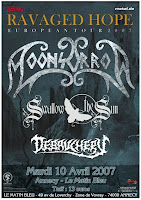The total running time of the EP was more than an hour, which is not the most usual for an EP. Actually, only one of their own albums (
Verisäkeet) lasts for more than one hour. Some people said: I don't know why they call it an EP if it lasts more than an hour. Others complained: what a rip-off album, only one new song and the rest covers and old stuff. They were actually answering each other: the band called it an EP because of that covers-and-old-stuff thing, and in fact emphasized a lot that it was in no way the sixth Moonsorrow album, even the title that appears in the cover is
Tulimyrsky EP, thus leaving no possibility of misunderstanding - something similar to what Metallica did with their
The garage days re-revisited: The $5.98 EP. A good thing was that it came out at EP price. "We just didn't want to do this half-way but decided to give the fans their money's worth with an overlengthy EP", stated Ville. The release was planned for March 26th, but it kept being pushed until April 30th, when it finally came out. I think nobody knew what to expect, some fans were afraid it would be a "Hävitetty 3", but again they surprised. The new song had elements from
V&K and from
Kivenkantaja, more melodic and faster, as well as from the two previous ones, with rougher sounds; and even a couple of parts so fast and aggressive that they remind
Tämä ikuinen talvi. Besides this mixture of elements from all periods, of course they
 Tulimyrsky
Tulimyrsky front cover
maintained their usual epic sound, but there was something new: it was very evident that there was a story being told there. All of almost all their songs tell stories, but this case was different, it was obvious that "Tulimyrsky" was a narration with its introduction, development and ending. For the second time, the booklet comes without the translations, because apparently, even though it's translated by Ville, he then sends it to someone else to correct it, and the correction didn't arrive on time. We had to wait until September to see the translation in their site; the Finns were probably very happy with the story, but the rest, until then, had to content ourselves with guessing that here's a battle, here's a description of the landscape and this final part is a triumphal chant of those who won. Indeed, the song tells a story of swords, and is the continuation of the facts narrated in
Voimasta. In this occasion, the attacked ones of the first story become the attackers, thus taking their revenge. Special mention is deserved by the illustration that comes with it, made by Belgian artist Kris Verwimp. The cover is a simple seaside landscape, with water and mountains in the background, very similar to Bathory's
Nordland; nothing
a priori that may remind a firestorm. When you unfold the whole sheet, you find out a magnificent drawing that shows some Viking longships in a shore and a horde of warriors burning a village. For me, it's undoubtedly the best Moonsorrow cover so far. The banner of this biography blog is an early sketch by Kris for that cover.

Click on this masterpiece to see it in 300 glorious DPI
Let's go back to the beginning of April. The second day of that month, Moonsorrow embarked a new touring festival called Paganfest, which took them around Europe together with Ensiferum, Korpiklaani, Eluveitie and Týr. (That was the first Paganfest; it would be repeated in consecutive years with different line-ups.) From day 2 until 22, one concert per night. But then they encountered a problem that at this time seemed unlikely: a guy from the German anti-fascist organization BIFFF learnt about their next concert in the pub “SO36”, Berlin on 17th, and wrote a statement informing that the venue had programmed a festival of “extreme right music” with bands that, according to him, exhibited nazi symbols, xenophobic lyrics and so on and on. The text criticized Ensiferum for their martial-looking photos; Týr for their usage of the rune of the same name and for showing a blood stained sword in one of their covers, even mocking the note they have in their website saying that they have nothing to do with politics; Eluveitie for calling themselves


Paganfest Europe 2008: standard and Budapest posters
Celts; but the worst part was for Moonsorrow, who had more charges: to begin with, in their website they called themselves “crusaders of epic heathen metal”; the S in their logo is the Sigel rune, the same that appears in the nazi SS logo; in their official biography they claim to have “a good touch of national romanticism and a distinctively pagan approach”; in the lyrics of several songs in the early albums they talk about warriors and raising swords against the enemy. Concerning lyrics, the most attacked song was “Luopion veri” (“one of their hits” according to that site - I doubt they have played it after 2001, if ever), for being clearly anti-Christian, and some lines about beheading the invader in the name of the gods sound fascist when taken out of context. The author of the text compared these lyrics to those of an ancient national-socialist anthem. Even the Guild of the Runescratchers who made the stone for
Kivenkantaja was criticized, because this German dude found the link in their site and also attacked them because of their pictures of runes.















































